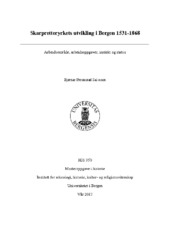Skarpretteryrkets utvikling i Bergen 1531-1868
Master thesis
Permanent lenke
https://hdl.handle.net/1956/17025Utgivelsesdato
2017-06-17Metadata
Vis full innførselSammendrag
This master thesis has its focus on the profession of executioners in Bergen, Norway. The main issue it attempts to explore is: how did the profession of executioners develop in Bergen between 1531 and 1868? To provide insight into this question, four topics have been discussed: 1) the geographical working area, 2) work responsibilities, 3) economic income, and 4) social status. The executioners in Bergen have also been compared to executioners from other areas in Norway. The sources show that the occupation in Bergen share a lot of the same history and development with the occupation`s history other places in Scandinavia (shown in the research literature). We do not know much about the early period of the profession (1531-1627). However, the paper suggests that before the 1660s they were municipal officials, worked as knackers (e.g. burying “unclean” and “dishonourable” dead bodies), were responsible for relatively small geographical areas and received a smaller economical income than after the 1660s. After the 1660s the situation changed. They stopped performing working as knackers, the geographical working area increased, the wages were raised, and they became royal officials. Thus, their social status grew. Further, from c. 1500-1640s most executioners in Bergen were Norwegians. From the 1640s-1830s however, surnames such as Kordt, Høcker, Helmschläger, Giørtler and Mühl-hausen appears in the sources, suggesting they were German and Danish immigrants (the latter from German descent). In contrast to the former Norwegian executioners, these immigrants were trained in the profession. From 1828/35, the immigration of skilled executioners stopped, and the physical punishments were again the responsibility of untrained Norwegians. Samson Isberg was the last executioner in Bergen, and from 1849 he became the sole executioner throughout Norway. Also, from the 1830s, the Bergen executioners were no longer royal officials. The thesis ends with the suggestion that the history of the profession in Bergen was not the same as in other places in Norway. For example, in 1719, Trondheim still had a former thief with only one ear and who worked as knacker, as executioner. Not before 1720 did they get their first executioner from Germany, who was trained and kept a higher social status than the former Norwegian executioners. Therefore, the history of the occupation in Bergen is not representative of the history of the occupation in Norway. This paper shows that this profession changed a lot in Bergen in the period 1531-1868. However, the changes did not happen steadily. The four topics that have been discussed changed back and forth many times.
